Articles
- Page Path
- HOME > Korean J Community Nutr > Volume 23(6); 2018 > Article
-
Research Article
- Risk of Metabolic Syndrome according to Intake of White Rice and Kimchi in Korean Adults: based on the 6th Korea National Health and Nutrition Examination Survey, 2013–2015
-
Jin-Su Kim, So Hyun Ahn, Sook Mee Son

-
Korean Journal of Community Nutrition 2018;23(6):525-537.
DOI: https://doi.org/10.5720/kjcn.2018.23.6.525
Published online: December 31, 2018
1Department of Clinical Nutrition, Research Institute & Hospital, National Cancer Center, Goyang 10408, Korea, Internship.
2Department of Food and Nutrition, The Catholic University of Korea, Bucheon, Korea, Instructor.
3Department of Food Science and Nutrition, The Catholic University of Korea, Bucheon, Korea, Professor.
- Corresponding author: Sook Mee Son. Department of Food and Nutrition, 43, Jibong-ro, Bucheon-si, Gyeonggi-do 14662, Korea. Tel: (02) 2164-4318, Fax: (02) 2164-4310, sonsm@catholic.ac.kr
Copyright © 2018 The Korean Society of Community Nutrition
This is an Open-Access article distributed under the terms of the Creative Commons Attribution Non-Commercial License (http://creativecommons.org/licenses/by-nc/3.0/) which permits unrestricted non-commercial use, distribution, and reproduction in any medium, provided the original work is properly cited.
- 1,671 Views
- 8 Download
- 4 Crossref
Abstract
-
Objectives
- This study was conducted to examine the relationship between white rice and Kimchi intakes and the risk of metabolic syndrome (Mets) in Korean adults.
-
Methods
- Dietary intake and health data of 8289 subjects aged 19 years and over from the 2013–2015 Korea National Health and Nutrition Examination Survey (KNHANES) were used. Daily total intake of white rice and Kimchi was assessed by 24-hour recall data. Multivariate logistic regression analysis was used to estimate the risk of Mets according to the daily intake of white rice and Kimchi.
-
Results
- The highest intake of white rice and Kimchi was associated with a higher risk of metabolic syndrome (Q1 vs Q5, multivariable adjusted OR=1.45, 95% CI: 1.03–2.03) in women. In addition, a significantly increased risk of elevated blood pressure (multivariable adjusted P for trend 0.0459) was associated with a higher intake of white rice and Kimchi in women. There was no significant trend in the risk of metabolic syndrome according to the intake of white rice and Kimchi in men.
-
Conclusions
- A higher intake of white rice and Kimchi was only associated with an increased risk of metabolic syndrome in women indicating it is necessary to consume more various food groups beside white rice and Kimchi, especially in women.
- 1. Grundy SM, Cleeman JI, Daniels SR, Donato KA, Eckel RH, Franklin BA, et al. Diagnosis and management of the metabolic syndrome: an American Heart Association/National Heart, Lung, and Blood Institute scientific statement. Circulation 2005; 112(17): 2735-2752.ArticlePubMed
- 2. Reaven GM. Role of insulin resistance in human disease. Diabetes 1988; 37(12): 1595-1607.ArticlePubMedPDF
- 3. DeFronzo RA, Ferrannini E. Insulin resistance: a multifaceted syndrome responsible for NIDDM, obesity, hypertension, dyslipidemia, and atherosclerotic cardiovascular disease. Diabetes Care 1991; 14(3): 173-194.ArticlePubMedPDF
- 4. Grundy SM, Brewer HB Jr, Cleeman JI, Smith SC Jr, Lenfant C. Definition of metabolic syndrome: report of the National Heart, Lung, and Blood Institute/American Heart Association conference on scientific issues related to definition. Circulation 2004; 109(3): 433-438.ArticlePubMed
- 5. Lim S, Shin H, Song JH, Kwak SH, Kang SM, Yoon JW, et al. Increasing prevalence of metabolic syndrome in Korea: The Korean National Health and Nutrition Examination Survey for 1998-2007. Diabetes Care 2011; 34(6): 1323-1328.PubMedPMC
- 6. Tran BT, Jeong BY, Oh JK. The prevalence trend of metabolic syndrome and its components and risk factors in Korean adults: results from the Korean National Health and Nutrition Examination Survey 2008–2013. BMC Public Health 2017; 17(1): 71-78.ArticlePubMedPMCPDF
- 7. Aguilar M, Bhuket T, Torres S, Liu B, Wong RJ. Prevalence of the metabolic syndrome in the United States, 2003-2012. JAMA 2015; 313(19): 1973-1974.ArticlePubMed
- 8. Song Y, Joung H. A traditional Korean dietary pattern and metabolic syndrome abnormalities. Nutr Metab Cardiovasc Dis 2012; 22(5): 456-462.ArticlePubMed
- 9. Ahn Y, Park SJ, Kwack HK, Kim MK, Ko KP, Kim SS. Rice-eating pattern and the risk of metabolic syndrome especially waist circumference in Korean Genome and Epidemiology Study(KoGES). BMC Public Health 2013; 13(1): 61-71.ArticlePubMedPMCPDF
- 10. Song SJ, Lee JE, Paik H, Park MS, Song YJ. Dietary patterns based on carbohydrate nutrition are associated with the risk for diabetes and dyslipidemia. Nutr Res Pract 2012; 6(4): 349-356.ArticlePubMedPMC
- 11. Song SJ, Lee JE, Song WO, Paik H, Song Y. Carbohydrate intake and refined-grain consumption are associated with metabolic syndrome in the Korean adult population. J Acad Nutr Diet 2014; 114(1): 54-62.ArticlePubMed
- 12. Kang JH, Kim KA, Han JS. Korean diet and obesity. J Korean Soc Study Obes 2004; 13(1): 34-41.
- 13. Kim J, Jo I. Grains, vegetables, and fish dietary pattern is inversely associated with the risk of metabolic syndrome in South Korean adults. J Am Diet Assoc 2011; 111(8): 1141-1149.ArticlePubMed
- 14. Lim H, Kim SY, Wang Y, Lee SJ, Oh K, Sohn CY, et al. Preservation of a traditional Korean dietary pattern and emergence of fruit and dairy dietary pattern among adults in South Korea : secular transitions in dietary patterns of a prospective study from 1998 to 2010. Nutr Res 2014; 34(9): 760-770.PubMed
- 15. Joung H, Hong S, Song Y, Ahn BC, Park MJ. Dietary patterns and metabolic syndrome risk factors among adolescents. Korean J Pediatr 2012; 55(4): 128-135.ArticlePubMedPMC
- 16. Kim HJ, Ju SY, Park CR, Park YK. Relationship between Kimchi and metabolic syndrome in Korean adults: data from the Korea National Health and Nutrition Examination Surveys (KNHANES) 2007~2012. J Korean Diet Assoc 2016; 22(3): 151-162.Article
- 17. Hyun T, Seo SH, Han YH, Song Y. Kimchi consumption and the incidence of metabolic syndrome in Korean adults : results from 10-year longitudinal study. FASEB J 2017; 31(1S): 789-7.15.
- 18. Son SM, Park YS, Lim HJ, Kim SB, Jeong YS. Sodium intakes of Korean adults with 24-hour urine analysis and dish frequency questionnaire and comparison of sodium intakes according to the regional area and dish group. Korean J Community Nutr 2007; 12(5): 545-558.
- 19. Yon M, Lee Y, Kim D, Lee J, Koh E, Nam E, et al. Major sources of sodium intake of the Korean population at prepared dish level: -based on the KNHANES 2008–2009. Korean J Community Nutr 2011; 16(4): 473-487.Article
- 20. Song DY, Park JE, Shim JE, Lee JE. Trends in the major dish groups and food groups contributing to sodium intake in the Korea National Health and Nutrition Examination Survey 1998–2010. Korean J Nutr 2013; 46(1): 72-85.Article
- 21. Yoo JE, Kim JS, Son SM. Risk of metabolic syndrome according to intakes of vegetables and Kimchi in Korean adults: Using the 5th Korea National Health and Nutrition Examination Survey 2010-2011. Korean J Community Nutr 2017; 22(6): 507-519.ArticlePDF
- 22. Kim MK, Kim K, Shin MH, Shin DH, Lee YH, Chun BY, et al. The relationship of dietary sodium, potassium, fruits and vegetables intake with blood pressure among Korean adults aged 40 and elder. Nutr Res Pract 2014; 8(4): 453-462.ArticlePubMedPMC
- 23. Kang M, Joung H, Lim JH, Lee YS, Song YJ. Secular trend in dietary patterns in a Korean adult population, using the 1998, 2001, and 2005 Korean National Health and Nutrition Examination Survey. Korean J Nutr 2011; 44(2): 152-161.Article
- 24. Parks EJ, Hellerstein MK. Carbohydrate-induced hypertriacylglycerolemia: historical perspective and review of biological mechanisms. Am J Clin Nutr 2000; 71(2): 412-433.ArticlePubMed
- 25. The Ministry of Health and Welfare. The Korean Nutrition Society. Dietary reference intakes for Koreans. 2nd revision. Seoul: The Korean Nutrition Society; 2015.
- 26. Villegas R, Liu S, Gao Y, Yang G, Li H, Zheng W, et al. Prospective study of dietary carbohydrates, glycemic index, glycemic load, and incidence of type 2 diabetes mellitus in middle-aged Chinese women. Arch Intern Med 2007; 167(21): 2310-2316.ArticlePubMed
- 27. Murakami K, Sasaki S, Takahashi Y, Okubo H, Hosoi Y, Horiguchi H, et al. Dietary glycemic index and load in relation to metabolic risk factors in Japanese female farmers with traditional dietary habits. Am J Clin Nutr 2006; 83(5): 1161-1169.ArticlePubMed
- 28. Radhika G, Van Dam RM, Sudha V, Ganesan A, Mohan V. Refined grain consumption and metabolic syndrome in urban Asian Indians (Chennai Urban Rural Epidemiology Study 57). Metab Clin Exp 2009; 58(5): 675-681.PubMed
- 29. Kim K, Yun SH, Choi BY, Kim MK. Cross-sectional relationship between dietary carbohydrate, glycaemic index, glycaemic load and risk of the metabolic syndrome in a Korean population. Br J Nutr 2008; 100(3): 576-584.ArticlePubMed
- 30. Choi H, Song S, Kim J, Chung J, Yoon J, Paik H. High carbohydrate intake was inversely associated with high-density lipoprotein cholesterol among Korean adults. Nutr Res 2012; 32(2): 100-106.ArticlePubMed
- 31. Park SH, Lee KS, Park HY. Dietary carbohydrate intake is associated with cardiovascular disease risk in Korean: analysis of the third Korea National Health and Nutrition Examination Survey. Int J Cardiol 2010; 139(3): 234-240.PubMed
- 32. Gaziano JM, Buring JE, Breslow JL, Goldhaber SZ, Rosner B, Van B, et al. Moderate alcohol intake, increased levels of high-density lipoprotein and its subfractions, and decreased risk of myocardial infarction. N Engl J Med 1993; 329(25): 1829-1834.ArticlePubMed
- 33. Park SH, Kang YH, Park HY. Alcohol consumption and the coronary heart disease-related risk factors in Korean adults: the Third Korea National Health and Nutrition Examination Survey (KNHANES III) 2005. Korean J Nutr 2008; 41(3): 232-241.
- 34. Son SM, Huh GY. Dietary risk factors associated with hypertension in patients. Korean J Community Nutr 2006; 11(5): 661-672.
- 35. Appel LJ, Brands MW, Daniels SR, Karanja N, Elmer PJ, Sacks FM. Dietary approaches to prevent and treat hypertension: a scientific statement from the American Heart Association. Hypertension 2006; 47(2): 296-308.ArticlePubMed
- 36. Morris RC Jr, Sebastian A, Forman A, Tanaka M, Schmidlin O. Normotensive salt sensitivity effects of race and dietary potassium. Hypertension 1999; 33(1): 18-23.ArticlePubMed
- 37. de La Iglesia R, Loria-Kohen V, Zulet MA, Martinez JA, Reglero G, Ramirez de Molina A. Dietary strategies implicated in the prevention and treatment of metabolic syndrome. Int J Mol Sci 2016; 17(11): pii: E1877.
- 38. Chen JP, Chen GC, Wang XP, Qin L, Bai Y. Dietary fiber and metabolic syndrome: A meta-analysis and review of related mechanism. Nutrients 2017; 10(1): pii: E24.
- 39. Kang Y, Kim J. Gender difference on the association between dietary patterns and metabolic syndrome in Korean population. Eur J Nutr 2016; 55(7): 2321-2330.ArticlePubMedPDF
- 40. Nanri A, Mizoue T, Noda M, Takahashi Y, Kato M, Inoue MS. Rice intake and type 2 diabetes in Japanese men and women the Japan Public Health Center: Based Prospective Study. Am J Clin Nutr 2010; 92(6): 1468-1477.ArticlePubMed
REFERENCES
General characteristics of Korean adults according to quintiles of white rice and Kimchi intake
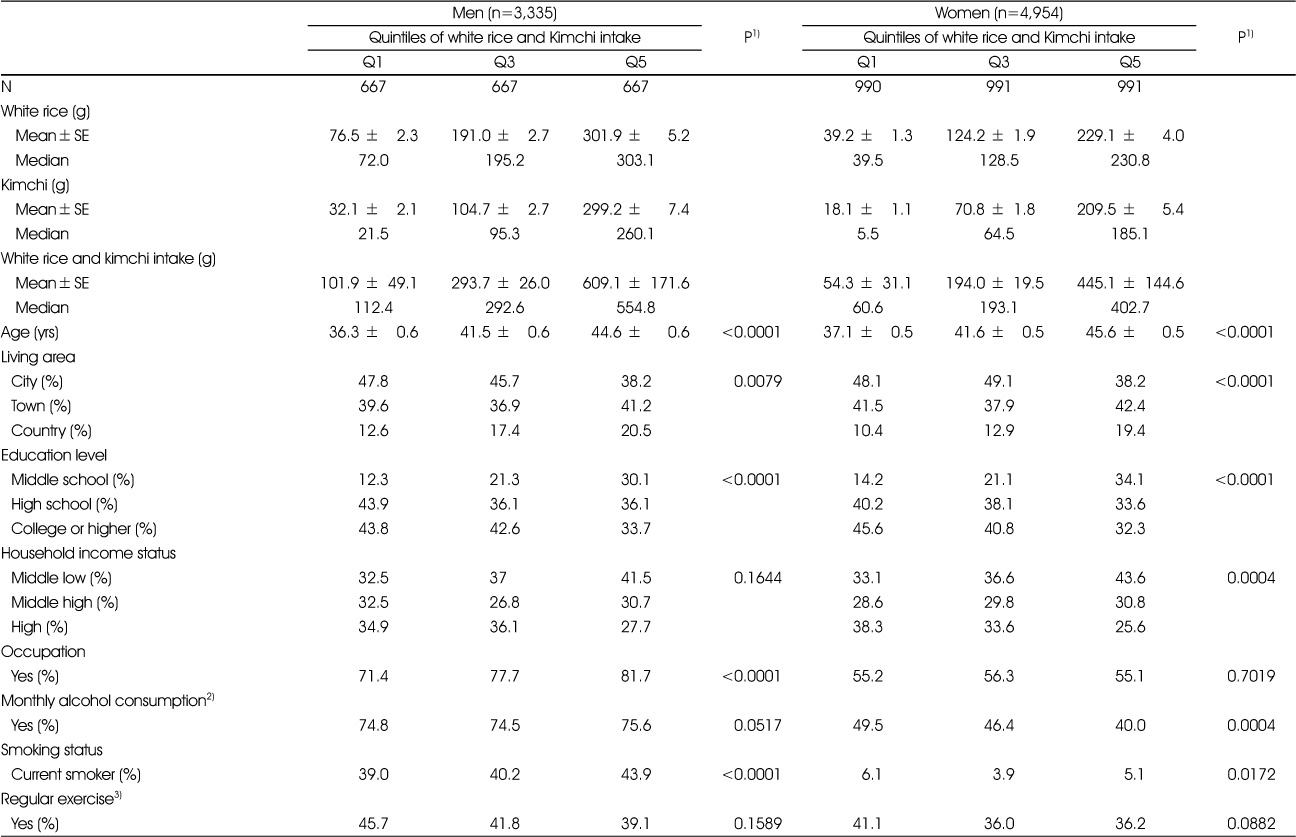
Values are expressed as mean±SE for continuous variables and percentage for categorical variables.
Q1, Q3, Q5 are the lowest, middle, and highest quintiles, respectively.
1) P value is P for trend determined by GLM for continuous variables and P for difference by Chi-square test for categorical variables.
2) Monthly alcohol consumption was defined as percentage of people who drank more than once a month for the past year.
3) Regular exercise was defined as walking at least 30 minutes a day, more than 5 times per week.
Energy and age adjusted food intake according to quintiles of white rice and Kimchi intake in Korean adults
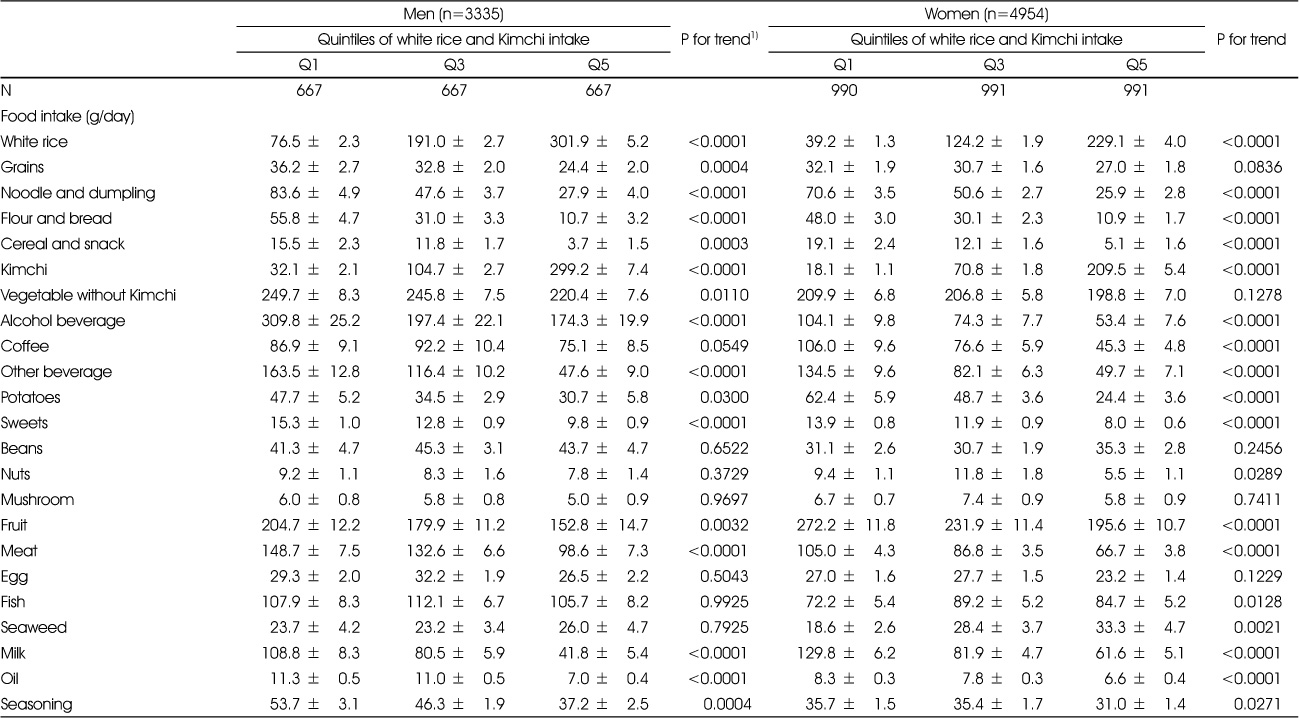
Energy and age adjusted nutrient intake according to quintiles of white rice and Kimchi intake in Korean adults
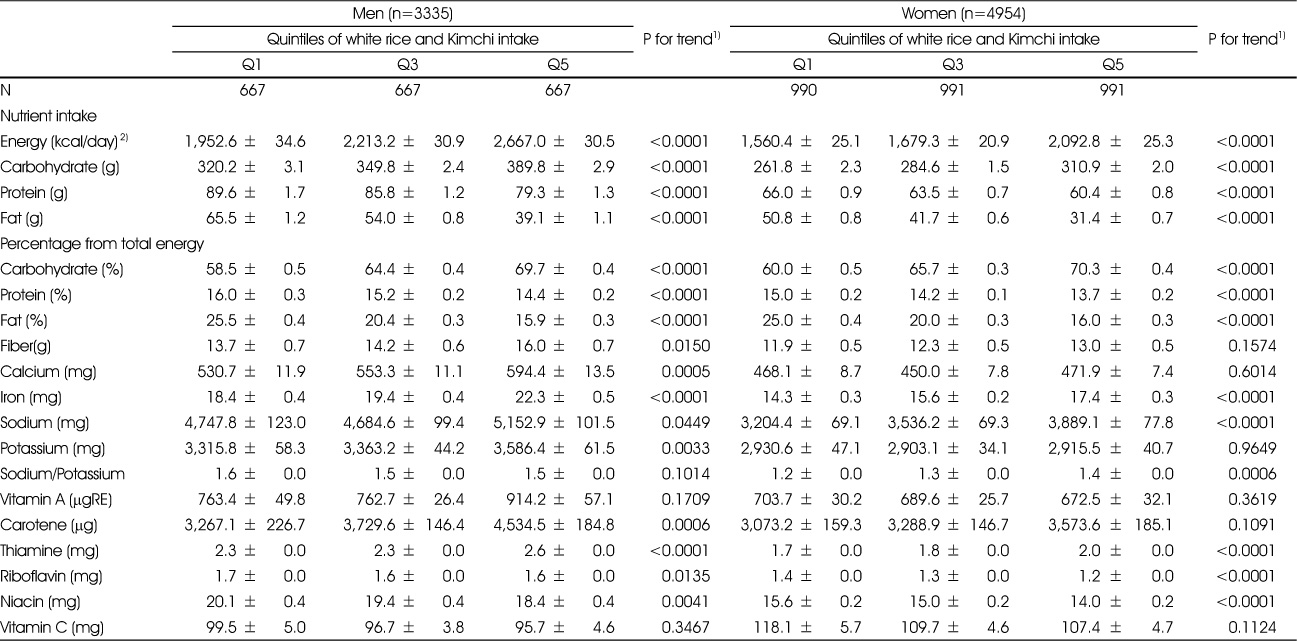
Figure & Data
REFERENCES
Citations

- Analysis of intake trends of kimchi, fruits and vegetables (1998–2020) and factors associated with the intake (2016–2020): based on the Korea National Health and Nutrition Examination Survey
Jiwon Jeong, Jungmin Park, Yu Kyung Lee, Sung Wook Hong, Sangah Shin
Journal of Nutrition and Health.2023; 56(4): 404. CrossRef - The Relationship Between the Korean Adults Diet Evaluated Using Dietary Quality Indices and Metabolic Risk Factors: Based on the 2016 ~ 2019 Korea National Health and Nutrition Examination Survey
Chong-Yu Ding, Pil-Sook Park, Mi-Yeon Park
Korean Journal of Community Nutrition.2022; 27(3): 223. CrossRef - Nutritional status and metabolic syndrome risk according to the dietary pattern of adult single-person household, based on the Korea National Health and Nutrition Examination Survey
Yu Been Keum, Qi Ming Yu, Jung-Sook Seo
Journal of Nutrition and Health.2021; 54(1): 23. CrossRef - Association of Korean fermented cabbage kimchi consumption with an incidence of metabolic syndrome: 10-year follow-up results of the Korean Genome and Epidemiology Study
Suk Hyeon Seo, Jiyoun Hong, Im Huei Son, Young Hee Han, Taisun Hyun
Journal of Nutrition and Health.2019; 52(6): 569. CrossRef
- We recommend
- Related articles
-
- Self-reported weight change and diet quality in relation to metabolic syndrome among Korean cancer survivors: a cross-sectional study using the Korea National Health and Nutrition Examination Survey 2019–2021
- Analysis of the relationship between sugar intake and cancer prevalence: a cross-sectional study using the 8th Korea National Health and Nutrition Examination Survey
- Trends in growth and nutritional status of Korean toddlers and preschoolers: a cross-sectional study using 2010–2021 Korea National Health and Nutrition Examination Survey data
- Total sugar intake and its contributed foods by age groups in Koreans using the 8th (2019–2021) Korea National Health and Nutrition Examination Survey: a cross-sectional study
- Comparison of blood biochemical characteristics and dietary intake by sex in gastric cancer patients over 40 years in Korea based on 7th (2016-2018) Korea National Health and Nutrition Examination Survey: a cross-sectional study
General characteristics of Korean adults according to quintiles of white rice and Kimchi intake
Values are expressed as mean±SE for continuous variables and percentage for categorical variables.
Q1, Q3, Q5 are the lowest, middle, and highest quintiles, respectively.
1) P value is P for trend determined by GLM for continuous variables and P for difference by Chi-square test for categorical variables.
2) Monthly alcohol consumption was defined as percentage of people who drank more than once a month for the past year.
3) Regular exercise was defined as walking at least 30 minutes a day, more than 5 times per week.
Energy and age adjusted food intake according to quintiles of white rice and Kimchi intake in Korean adults
Values are presented as mean±SE.
Q1, Q3, Q5 are the lowest, middle, and highest quintiles, respectively.
1) P for trend determined by GLM adjusted for energy intake and age..
Energy and age adjusted nutrient intake according to quintiles of white rice and Kimchi intake in Korean adults
Values are presented as mean±SE
Q1, Q3, Q5 are the lowest, middle, and highest quintiles, respectively
1) P for trend determined by GLM adjusted for energy intake and age.
2) Mean±SE adjusted for age.
BMI and biochemical indicators by quintiles of white rice and Kimchi intake in Korean adults
Values are means±SE
Q1, Q3, Q5 are the lowest, middle, and highest quintiles, respectively.
1) P for trend determined by GLM
2) Adjusted for age, energy, living area, education level, house income status, occupation, monthly alcohol consumption, smoking status, regular exercise and BMI
Odds ratios and 95% confidence intervals for metabolic syndrome and components across quintile of white rice and Kimchi intake in Korean adults
1) Adjusted for age, energy, living area, education level, house income status, occupation, monthly alcohol consumption, smoking status, regular exercise and BMI
2) P for trend determined by GLM
Values are expressed as mean±SE for continuous variables and percentage for categorical variables. Q1, Q3, Q5 are the lowest, middle, and highest quintiles, respectively. 1) P value is P for trend determined by GLM for continuous variables and P for difference by Chi-square test for categorical variables. 2) Monthly alcohol consumption was defined as percentage of people who drank more than once a month for the past year. 3) Regular exercise was defined as walking at least 30 minutes a day, more than 5 times per week.
Values are presented as mean±SE. Q1, Q3, Q5 are the lowest, middle, and highest quintiles, respectively. 1) P for trend determined by GLM adjusted for energy intake and age..
Values are presented as mean±SE Q1, Q3, Q5 are the lowest, middle, and highest quintiles, respectively 1) P for trend determined by GLM adjusted for energy intake and age. 2) Mean±SE adjusted for age.
Values are means±SE Q1, Q3, Q5 are the lowest, middle, and highest quintiles, respectively. 1) P for trend determined by GLM 2) Adjusted for age, energy, living area, education level, house income status, occupation, monthly alcohol consumption, smoking status, regular exercise and BMI
1) Adjusted for age, energy, living area, education level, house income status, occupation, monthly alcohol consumption, smoking status, regular exercise and BMI 2) P for trend determined by GLM

 KSCN
KSCN
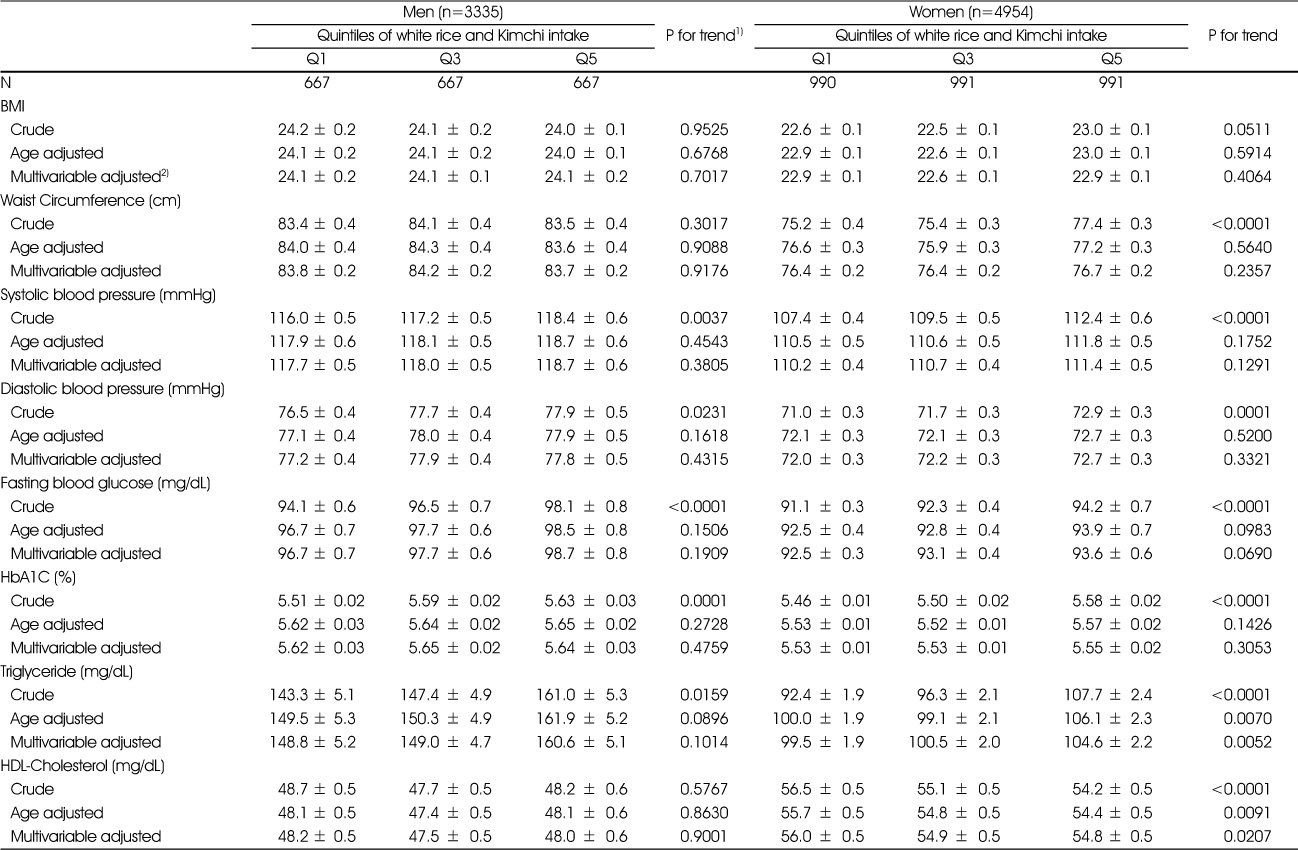
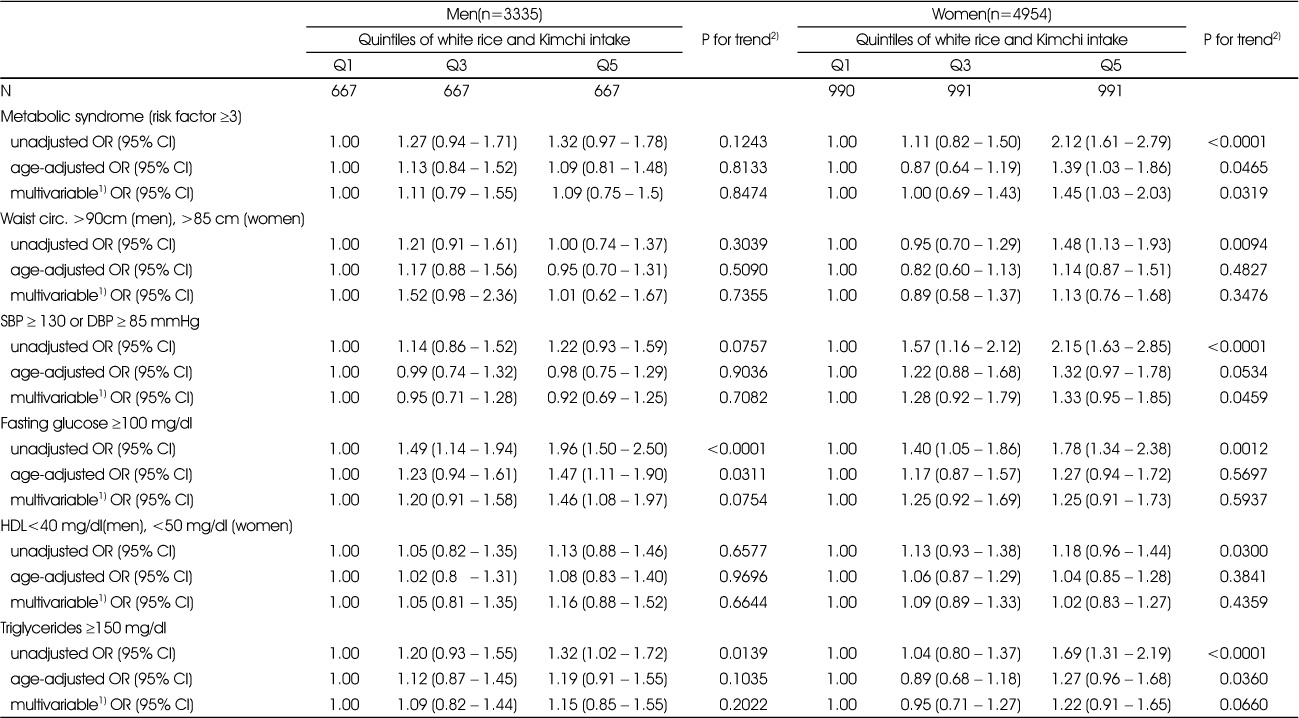
 Cite
Cite


